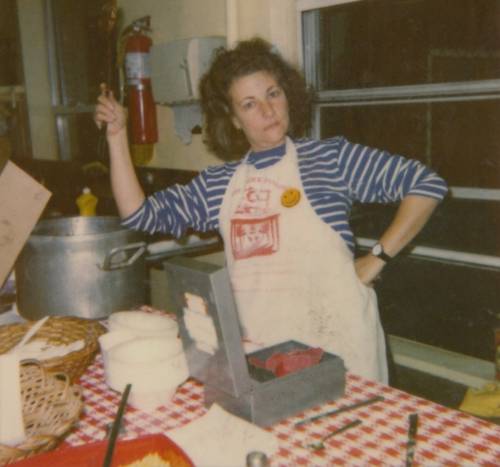In “Home Cooking,” a collection of essays first published in 1988, Laurie Colwin states one opinion after another, as plainly as boiled potatoes. “Grilling is like sunbathing,” she announces. “Everyone knows it is bad for you but no one ever stops doing it.” Along with outdoor cooking, outdoor dining is out, too: “I do not like to eat al fresco. No sane person does, I feel.” During Colwin’s brief career, and then well beyond it, countless readers and cooks have aspired to her idiosyncratic recipe for sanity and self-reliance. Its ingredients were laid out primarily in her columns for Gourmet (which “Home Cooking” collects), and, if Colwin’s opinions were bluntly put, they weren’t obvious: she insisted that simple chicken salad had “a certain glamour,” but rarely extolled chocolate (“I don’t love it”). She wasn’t a polished homemaker in the Betty Crocker tradition or a highly technical haute-cuisine enthusiast like Julia Child, and though she was a working woman in New York, she didn’t fit the type who returned from the office to a sad fridge full of SlimFast.
Colwin spoke, first and foremost, to harried middle-class cooks, assuring them that their inner “domestic sensualist” was within reach: you could be both a hedonist and a pragmatist if you mastered a few basic techniques, and splurged on a few not so basic ingredients. Through her writing, at once bossy and intimate, Colwin barged into kitchens and made herself at home, the kind of cook who grabs the spoon and starts mixing the batter her way. And you won’t be irked for long: her brown-sugar gingerbread with lemon brandy really is delicious.
Colwin was most prolific as a fiction writer—she published five novels and three story collections—but it is her culinary legacy that has aged best. When she died from an aortic aneurysm, in 1992, at the age of forty-eight, some four hundred heartbroken letters arrived at Gourmet, and nearly a thousand people crammed into her memorial service in Manhattan, many of whom had encountered her only through her writing. In the decades since, Colwin has become a saintly figure among a certain type of eager, urbane home cook who uses real butter and has at some point hosted an impromptu dinner for six. The tone of today’s food blogs is more casual than clucking, but, as a 2014 piece in the Times noted, there is still a “guardian-angel-style attachment” to Colwin’s strict ethos in the kitchen. And now Vintage and Harper Perennial are reissuing her work, including “Home Cooking,” “More Home Cooking,” and all her fiction.
As a food writer and a fiction writer, Colwin is a bard of burgeoning adulthood. Her forte is firsts: first shitty job, first apartment, first poached egg, first marriage, first affair, first homemade loaf of bread. She wrote about people with minds and lives not yet fully cooked, who are nervous about what everything will look like when it finally comes out of the oven. For much of Colwin’s twenties—the era of her own firsts—she lived in a tiny West Village apartment with two stove burners and no kitchen sink. In “Home Cooking,” she describes the best meal she ever ate there, after a night of heavy drinking, when a friend arrived bearing four veal scallops, two pears, a bunch of arugula, and a round of Boursault cheese. “We got out the card table and set it, and washed the arugula in the bathtub,” Colwin writes. That night, she squeezed comfort out of constraint, putting in the effort despite a pounding headache, because with Colwin just the right amount of effort—enough to dirty a dish but not zap your conversational energy—is always what’s required.
Colwin was born in 1944 into a Jewish family in New York. They moved around—Manhattan, Chicago, Long Island, Philadelphia—and what remained consistent throughout was food. Colwin’s father brought home smoked butterfish from Barney Greengrass on the Upper West Side, and took Laurie and her sister crabbing at Blue Point, Long Island. Her mother taught her to make comforting staples like potato pancakes, and may also have taught her to form and follow strong opinions about food; every year, Laurie’s birthday cake was “decorated with sugar roses, not buttercream, because my mother believes that buttercream turns in the hot weather.”
During high school, Colwin transformed her bedroom into a salon, hosting friends and smoking plenty of cigarettes. She went to Bard College for a while, and then to Columbia, but she hated school and never graduated. Before she dropped out, she found herself involved in the 1968 campus uprising, less as a protester than as a hostess, bringing giant trays of peanut-butter and tuna-fish sandwiches to students on the front lines. To anyone who complained about the selection, she had a ready retort: “You’re supposed to be eating paving stones like your comrades in Paris.” Someone slapped a piece of masking tape on her sweatshirt that said “Kitchen/Colwin.” “This, I feel, marked me for life,” she later wrote.

“That might be how you do things in Canada, but . . .”
Cartoon by Pia Guerra and Ian Boothby
Colwin, a committed New Yorker for her entire adulthood, started learning how to churn out gourmet meals in her twenties, but she didn’t begin writing food essays for a decade. She wanted to be a novelist, and published her first short story in this magazine, in 1969, when she was twenty-five years old. (That story, “The Man Who Jumped Into the Water,” follows a teen-age girl grappling with the suicide of a beloved neighbor.) Her fiction tends to be about well-off, well-educated white Manhattanites, who, despite leading mostly charming, puff-pastry lives, are filled with dread that their luck could one day disappear. Colwin, who wrote many of her novels while living in then grimy Chelsea, rarely ventured above midtown, but her protagonists—most of them women—typically orbit in uptown crowds (and trot about the city at night, even during its grittiest years).
These women are searchers, restless and often underpaid, and chronic interrogators of their own romantic and domestic instincts. Should they marry? Have children? Move to the country? Colwin’s abiding love of party-giving manifests in many of her characters as a kind of aesthetic tyranny, and her fiction shares the rarefied ambience of the nineteenth-century English novelists (Austen, Thackeray, Eliot) she admired. Her protagonists may not know how to live their lives, but they certainly know how to furnish them. They’re surrounded by silver coffee-service sets, mismatched porcelain, solid-oak desks, elegant floral arrangements, and dishes of imported olives.
“Happy All the Time” (1978), Colwin’s second novel, follows two couples living in New York City as they fall in love and move into ever-larger apartments. If Holly Sturgis is unsure about committing to her beau, she is resolute in her decorative decisions: “She decanted everything into glass and on her long kitchen shelves were row upon row of jars containing soap, pencils, cookies, salt, tea, paper clips, and dried beans. She could tell if one of her arrangements was off by so much as a sixteenth of an inch and she corrected it.” What gives Colwin’s work electric tension is that she cannot quite decide where to place her sympathies. She, too, loves beautiful things; one imagines that, like Holly, she has felt “the urge to straighten paintings in others people’s houses”—and may not always have restrained herself. Yet she also seems to understand that these frivolous concerns are covering up a void. Everything is in the right place, except the characters themselves, stuck between their wants and their needs.
Nowhere is this disjuncture more evident than in love and marriage. Colwin, who married the book editor Juris Jurjevics when she was thirty-nine (later than when most of her characters settle down), and stayed married until her death, could not stop writing about adultery. Her characters have stylish, cosmopolitan affairs, meeting for clandestine walks through art museums. But infidelity, in her work, is almost never a life-ruining or cataclysmic event. It is a way of gently testing the strength or the weakness of an existing relationship, of fine-tuning your domestic desires by venturing out.
Colwin’s characters are strivers—women who pride themselves on trying as hard as they can, while still worrying that they’re trying too hard. In “Happy All The Time,” Misty Berkowitz (whose husband describes her as having “the only Jew at the dinner table look”) can’t help but compare herself to the perky Gem Jaspar: “Gem stood for something—something effortless. Something that did not have to invent a personality in order to get by. . . . A million silkworms would lay down their lives so that Gem might have a shirt. Grooms went home to small, mortgaged homes so that Gem might stable her horse, and horses would be broken so that Gem might ride. Innumerable workers slaved anonymously so that Gem might be properly equipped. All Gem had to do was be.”
If, when it comes to romance, Colwin’s characters are jealous and confused, when it comes to food they are stubborn and rhapsodic. Desire leaves these women constantly hungry; with a good meal, at least, they can be briefly sated. In Colwin’s story “French Movie,” from a 1986 collection, Billy, a graduate student hopelessly in love with a married man, takes small comfort in the Chinese restaurant where each step of their romance (and, eventually, its demise) is marked by “the same meal: flat noodles with meat sauce, steamed broccoli, and fried fish.” In “Family Happiness,” from 1982, which follows Polly Solo Miller Demarest, an Upper East Side denizen in the throes of an affair with a louche painter, Colwin notes that juice in the Demarest household is always made fresh, because Polly’s father had believed that “liquid must never come into contact with paraffin, as in waxed cartons. The whole family backed him on this point, and everyone was happy to take turns squeezing oranges and grapefruits in the old-fashioned squeezer.” These rituals are grounding but fleeting, as food always is: meals come to an end; vegetables wither and wilt in the fridge.
Is there any enduring consolation? What people really want in life, Colwin writes in “Home Cooking,” is “an enormous return on a small investment. Almost the only situation in which this is possible is cooking.” In the kitchen, she discovered—and hoped her readers would, too—that recipes didn’t simply have to be followed; they could be invented. If romantic experiments could provide eventual insight, culinary ones yielded instant results. Effort didn’t guarantee success—the soufflé might collapse, the hollandaise might never emulsify—but through the vibrancy and the personality of her food writing Colwin showed that, in some sense, the work did always pay off. This kind of knowledge led her to a distinctively sure-footed approach, one she wanted to share with others. A beginner in the kitchen, Colwin writes, should “call up the best cook he or she knows and listen to what that person says. And then the novice should stick to it.”
Colwin is regularly compared to her contemporary Nora Ephron. They were both brunette Manhattanites with a keen ear for dialogue, a wry sense of humor, and killer vinaigrette recipes, but their spheres were distinct. Ephron, who had Hollywood money, often kicked off her dinner parties in the storied Apthorp building with pink champagne. One of Colwin’s favorite entertaining dishes was a hot dip made out of frozen spinach, evaporated milk, jalapeños, and cubes of Monterey Jack cheese. Writing about pot roast, Colwin laments that when she was starting out as a home cook “a substantial meat purchase seemed as daunting as buying an ermine stole. Therefore I settled on the cheaper chuck steak, cut thick, and I stand by it.” It’s in part out of budgetary concern, she says, that “Home Cooking” includes so many chicken recipes. (Though Colwin, who was ahead of the curve when it came to certain healthy-eating trends, does suggest serving pricier “organic chicken,” in order to avoid “feeding anabolic steroids to friends and loved ones.”)
In “French Movie,” Billy, the grad student, is fixated on her lover’s wealthy wife: Billy “had heard three or four or five times the story of how Vera had packed an entire set of yellow French crockery into her suitcase by seamailing all her clothes home from Paris.” By contrast, in “Home Cooking” Colwin suggests a minimalist approach to cookware. “Until I went to a tag sale and found a food mill for three dollars, the kitchen strainer and the wooden pestle were all I had to help me purée the soup or the vegetables,” she writes.

Colwin in the kitchen of a New York City school. Her simple, sumptuous dishes call for just the right amount of effort.
Colwin’s gospel was simple, sumptuous food done well: potato salad, crusty bread, beef-and-barley soup, shepherd’s pie, chocolate wafers, zucchini fritters. She wasn’t particular about process. “If you are civilized,” she wrote in one recipe, “you can arrange the vegetables on a plate and put the egg on top. If you are not, you can eat it right out of the pot.” She had a taste for delicacies, recommending Bibb lettuce with chunks of pâté de foie gras and lobster meat, but was never delicate about them: she proudly advertised this dish as “a salad loaded with cholesterol and fat.”
Colwin’s fans often gush about her anti-perfectionism in the kitchen. And it is true that Colwin is a generous apologist for gloppy casseroles and grainy fondues. She recalls an evening when she made a pasta so gluey that even her husband’s stoned friend noticed something was off. “Wouldn’t it be groovy if we could dump this whatever it is in the garbage and go out for dinner?” he wondered. (Colwin agreed.) With a novelist’s appreciation for a good story, she notes that “there is something triumphant about a really disgusting meal. It lingers in the memory with a lurid glow, just as something exalted is remembered with a kind of mellow brilliance.”
Ultimately, the joy of reading Colwin’s food writing is that she is doing much more than teaching you how to function in front of a stove. She has a few solid recipes—try the corn-bread-and-prosciutto stuffing—but her brusque kitchen style is really a sly way of urging you to trust the strength of your convictions. About cooking fried chicken, she writes, “Unfortunately, most people think their method is best, but most people are wrong.” (She’s against breading and deep-frying.) Still, her opinion wasn’t the only one that mattered (the “specific hatreds” of guests “should never be trifled with”), and she encouraged readers to form their own: experiment with spices, pick a favorite fish, bake a dessert enough times that you no longer need to look at a recipe card to make it. Competence was one of her goals, but confidence was the real point.
If confidence was what allowed Colwin to deem a botched meal “triumphant,” it didn’t mean she lacked empathy for those who lost hours, or even years, to wayward mistakes both in and out of the kitchen. “One of the things that bothers me about the way I am viewed is that people say, ‘Oh, the books have happy endings,’ ” Colwin said in a 1990 interview. “There is not one single happy ending in any book written by me. They are all unresolved endings.” The format of a recipe might seem to guarantee more closure: you can make Colwin’s cinnamon pears baked in a tagine perfectly on the first try, then serve up a happy ending at every dinner party thereafter. “Unless you want to live on cold cereal,” Colwin wrote of this dessert, “there’s nothing easier.” But writing about ease, for Colwin, is also a way of writing about difficulty. As she said of one story collection, “My mission was to describe a certain kind of struggle.”
Colwin’s titles are ironic—nobody is really “Happy All the Time.” A consummate doyenne who advises readers that “it is wise to have someone you adore talking to in the kitchen,” Colwin is nevertheless often on her own. In one of her finest essays, “Alone in the Kitchen with an Eggplant,” she calls the vegetable “the stove top cook’s strongest ally”—as if ingredients themselves were keeping her company. Cooking for herself, she “fried it and stewed it, and ate it crisp and sludgy, hot and cold.” She ate eggplant with honey and eggplant with Chinese plum sauce. She “ate it at my desk out of an old Meissen dish, with my feet up on my wicker footrest as I watched the national news.” Years later, Colwin writes, once she didn’t have to be alone, she still enjoyed this ritual. Today, her solo eggplant ceremony might be labelled as “self-care” (Use the nice china yourself! You deserve it!), but Colwin never offers recipes for total serenity; she is, after all, still watching the news while she eats. The pleasures of food, in her writing, are matter of fact. You get out of it what you put into it; you’ll enjoy eating the cake precisely because you made it.
At the end of “Happy All the Time,” the two couples escape New York and end up in Salt Harbor. They stay at the Scott’s Fisherman’s Inn, where guests can rent “rooms with kitchens for those inclined to eat their catch.” Colwin’s characters, of course, are inclined. The four friends are not fully at ease with one another, but eating together is one thing that comes naturally. Holly has brought her own salad dressing from home, along with “four wooden candlesticks and four beeswax candles.” She serves the group Lady Baltimore cake, a preposterous and precarious construction, filled with brandy and chopped dried figs and covered in frosting. They enjoy a bottle of champagne, but when it’s finished “they were suddenly sad.” Someone scrounges up another bottle, and they are momentarily relieved, raising their glasses to “a truly wonderful life.” We know better than to trust this toast; in the morning, they’ll have headaches. But for now the meal isn’t over. They believe what they say, and belief can be very filling. ♦
New Yorker Favorites
- How we became infected by chain e-mail.
- Twelve classic movies to watch with your kids.
- The secret lives of fungi.
- The photographer who claimed to capture the ghost of Abraham Lincoln.
- Why are Americans still uncomfortable with atheism?
- The enduring romance of the night train.
- Sign up for our daily newsletter to receive the best stories from The New Yorker.
Sourse: newyorker.com






